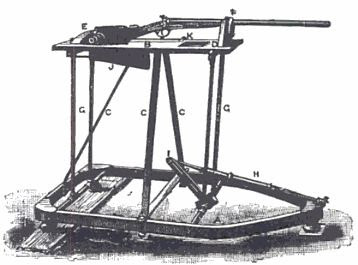A machine rest should ideally have the characteristic that it simulates a human shoulder or arm, so that it absorbs the recoil from a firearm as though a human were holding it. This is very important because if the machine rest is completely fixed, it will result in damage to the firearm's stock, bedding or recoil lugs. The machine rest should also be able to return back to zero (i.e.) back to its previous position before firing it. There should be some provision to pull the trigger by mechanical means, so that the trigger pull force and speed are consistent between shots. Some machine rests also have gauges to record the recoil force generated by the firearms as well.
In the above image, we have a machine rest designed in the 1890s, which was used by Field magazine to evaluate various firearms. It was made of iron, so that it was relatively portable. Points of interest are the spring balance H and toggle joint I. The spring balance records the recoil force and the toggle joint ensures that the varying strength of the spring at different positions is equalized out to provide a constant resistance. The device J, which is located under the stock of the rifle is an oil reservoir which has a cylinder and piston. This returns the firearm slowly back to its initial firing position, after it has been discharged.
Here's what a typical modern machine rest for rifles looks like:
This particular modern rifle rest is made by Hyskore and has interchangeable shock absorbers (compression dampers) for different rifle types. In this particular model, the shock absorbers are filled with nitrogen gas. It also has various knobs to adjust elevation and windage precisely and aim the rifle to the target. In addition, it has a remote controlled hydraulic trigger pull, so that there is consistency between one trigger pull and the next.
Next, we will look at another well known brand of machine rests used for handguns:
The above is a Ransom International made rest, which is pretty much the gold-standard when it comes to accuracy testing of handguns. Ransom International introduced the Master Series Rest into the market in 1969 and the Master Series models are still being sold today. In fact, most major handgun manufacturers use this model for accuracy testing. Like the other rests, this also simulates the grip and recoil absorption of a human hand very closely and it also has the facility to return the firearm back to its initial position after the shot. The trigger is activated by a little lever on the side, to provide consistent trigger pulls each time.
While major manufacturers use machine rests to ensure quality control of their products, these are also used by owners to evaluate their firearms and ammunition brands. For example, ammunition from different manufacturers come in different qualities. A tester can shoot X rounds each from different brands and determine which ammunition manufacturer produces cartridges that shoot uniformly best. Also, many new semi-automatic pistols have a tendency to shoot the first cartridge in the magazine in a different place than the other ones. Using a machine rest allows a tester to evaluate if a particular pistol has this characteristic. Some revolvers sometimes have some chambers in the cylinder that shoot at a different point than the rest of the chambers. Using a machine rest allows the tester to mark out which chamber(s) shoot differently and perhaps not load those chambers.














No comments:
Post a Comment